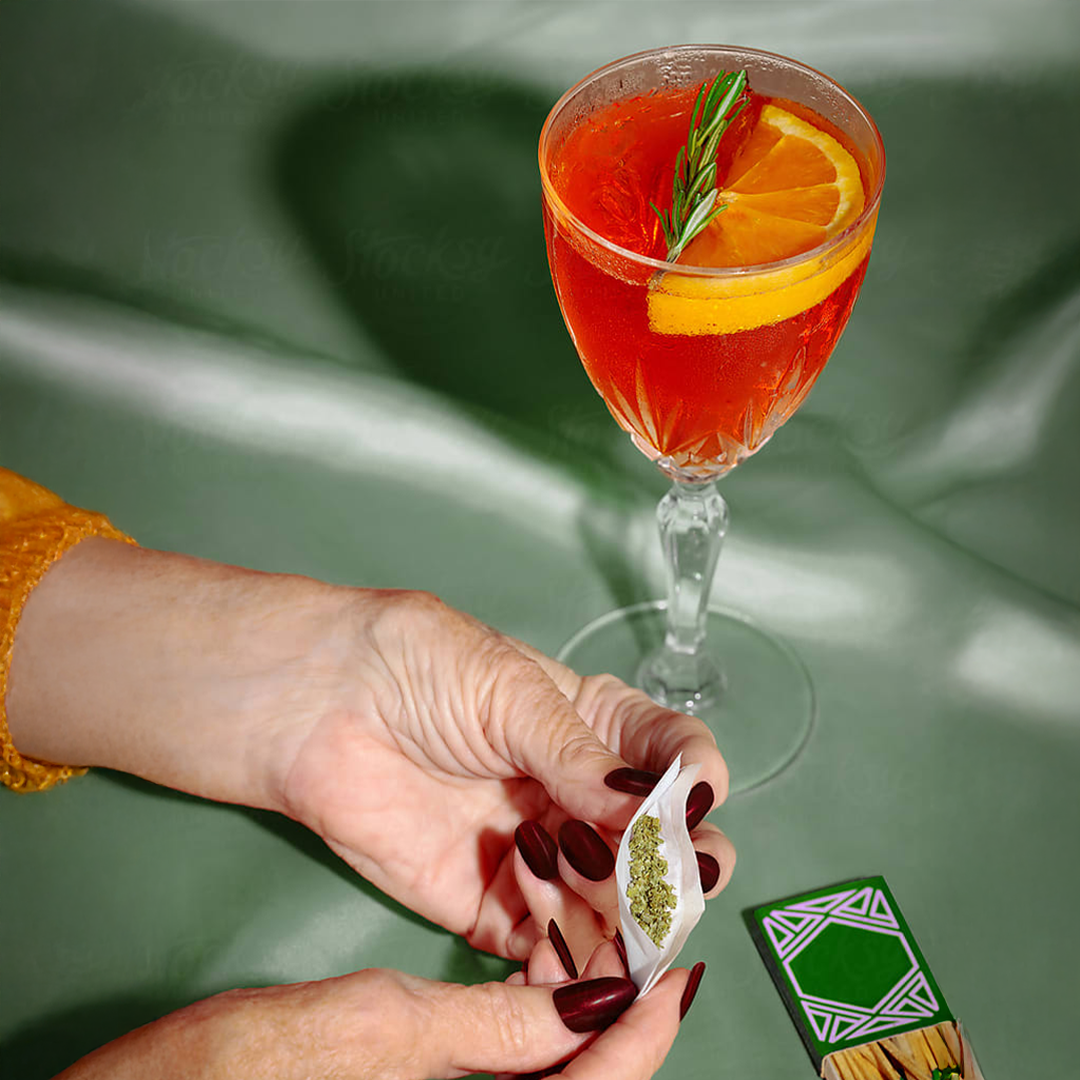If you’ve had any experience with using cannabis (or even if you haven’t), you’ll know that the plant comes with whole subcultures and languages of its own. If anyone’s ever hit you with a slang word or a medical term that you don’t understand—but know it’s got something to do with weed—you’ll also know that cannabis-related words can be as intimidating, problematic and/or “inside baseball” as they are chill to learn.
Between grower words, science words, recreational words, and industry lingo—there’s a lot to learn when you’re first diving into (or just deepening your relationship to) the world of cannabis.
That’s why we’ve created the ultimate, but not-at-all scary, Miss Grass guide to the words we use often. Consider it your one-stop shop to cross-reference the meaning of stuff. ~ The more you know! ~
Modes of Ingestion (in alphabetical order)
Bong
A type of water pipe used to smoke cannabis (or other substances). Usually made of ceramic, glass or DIY objects, the user lights the flower (cannabis) on a small bowl, then inhales it through water, which allows the smoke to cool down before being breathed in.
Dabbing
One method of consuming by heating a highly potent cannabis concentrate (butane hash oil, which is also known as dabs, wax, or shatter) on a hot surface and inhaling the smoke.
Edibles
Any cannabis-infused food or drink item consumed for recreational or medical purposes, including gummies, cookies, sodas, brownies, olive oil, and more. While the high from edibles takes longer to feel—typically between one to two hours—it can result in a more intense high that often lasts longer because cannabinoids need to pass through the gastrointestinal tract and ultimately, through the liver.
Hash
Otherwise known as hashish, this is the highly potent resin found in the trichomes (the little tiny crystal-like hairs that cover the buds of the cannabis plant). It can be rolled into joints, vaporized in a bong, or used to cook with.
Joint / Pre-Roll
A cannabis-filled cigarette made by hand (or via a rolling machine) with cigarette-like rolling paper. Pre-rolled joints or “pre-rolls” are ready-made, packaged joints you can purchase in dispensaries or stores. Joints are also often called spliffs.
One-Hitter
A light, portable pipe with a small bowl for putting just enough cannabis in for one hit, or one inhalation. A one-hitter is thus perfect introductory smoking device for new cannabis users and often comes in discrete designs.
Sublingual
A method of consuming by placing drops of cannabis extract (usually CBD) from a tincture under one’s tongue. This works well because the mucosal lining of the mouth in can quickly absorb the compounds in a fast-acting way.
Topical
A cannabis product like a lotion, cream, spray, or balm, made to be absorbed through the skin to treat everything from injuries and muscle pain, to dry skin and psoriasis.
Vaping / Vaporizer
A method of consuming cannabis in dried or oil form via an inhalation device, but without the burning or smokeof joints. Instead, the device (usually a vape pen) heats the substance so the vapors may be easily breathed in. This is a popular mode of ingestion because it’s discreet and can be done indoors without making the place smell of smoke.
Common Terminology
4/20
A code word used to describe both the time of day people traditionally associate with getting high, and also the date each year that people celebrate as cannabis’ global day.
Bud / Ganja / Grass / Weed / Pot
The most commonly accepted slang terms used to describe cannabis, especially as it relates to smoking high-THC varietals of the plant.
Budtender
The very helpful person who works at a dispensary or cannabis retail store and can advise you on what products to try. Speak to them about your experiences, preferences, and general needs to get the most out of your trip to the medical dispensary or the store.
Dispensary
Any business location where a patient or customer can purchase cannabis legally and safely. Dispensaries is most used as the umbrella term for any medical pick-up location, access point, co-op, retail storefront, or distributor.
Flower
A way of referring to the part of the cannabis plant that you smoke. Cannabis flowers are the “female” reproductive organs of the plant, which look hairy, sticky, and are covered in tiny crystals (trichomes).
Marijuana vs. Cannabis
Marijuana is an outdated, pejorative term for cannabis, referring to the flowering buds on the plant.
Roach
When a joint is almost fully consumed, the last remaining bit is referred to as the roach. And because it is so short by that time, it can be treacherous to hold, so many people like to use a roach clip to help hold it until it’s fully smoked.
Plant & Varietal Words
Hemp
A varietal of sativa with higher amounts of CBD (and less than 0.3 percent THC) . Historically, hemp was grown for industrial purposes such as oils, lotions, fibers, and even building materials. But more and more, and with the passing of the Farm Bill in 2018, hemp is being grown for medicinal purposes too.
Hybrid
A “hybrid” species of cannabis plant made by cross-breeding two plant varietals, for a combination of their unique effects.
Indica & Sativa
Dated classifications that describe varietals of the cannabis plant with sedative qualities and relaxing physical effects. Nowadays, it’s more common for people in the know to consider the entire chemistry of a plant. Depending on who you talk to, classifications like “indica,” “sativa” and “hybrid” are still very much in use. However, these classes are no longer relevant. See Cannabinoid & Terpene Profile and Strain vs. Cultivar vs. Varietal.
Strain vs Cultivar vs Varietal
Because of the continued hybridisation of the plant, it’s no longer possible to distinguish between exclusively indica or sativa strains. Instead, people are moving towards using the terms “cultivar” or “varietal” in order to emphasize the potency of cannabinoids and the terpene profile found within each plant. See Indica & Sativa.
Medical & Science Terms
Cannabidiol / CBD
The dominant non-psychoactive cannabinoid found in cannabis and is known for its ability to manage pain, increase calm, and reduce inflammation, as well as help with a host of other benefits.
CBD Isolate vs. Full-Spectrum
CBD isolate is cannabidiol in the purest form, meaning that the CBD is isolated from all other compounds and terpenes in a process of refinement. Full spectrum refers to any CBD extract or substance that contains the full suite of cannabinoids, terpenes, plant matter and flavonoids from the plant. See Entourage Effect.
Cannabinoid
There are more than 100 known cannabinoids found in cannabis—the chemical compounds unique to the plant. THC, CBD, and CBN are the most widely known. Other ones that are picking up in popularity are THCV, THCA, CBG.
Cannabinoid and Terpene Profile
The mix of compounds (cannabinoids and terpenes) found in a strain of cannabis. Identifying their cannabinoid and terpene profile means understanding how to properly classify plants and what they can best be used for.
CBN
A cannabinoid found in the cannabis plant that’s known for its pain-relieving and sedative qualities. Apparently a dose of CBN can have the same effect as an over-the-counter sedative that’s double the strength. It’s also known as an antibacterial and can even modify appetite.
Endocannabinoid System (ECS)
The endocannabinoid system (ECS) is a network of receptors and compounds found in every mammal. It’s there to maintain the body’s equilibrium or homeostasis, which is fancy speak for regulating things like pain, appetite, sleep, immune function, neurogenesis and stress. The ECS is also what interacts directly with the active ingredients in cannabis.
Entourage Effect
The idea that the compounds found in the cannabis plant—cannabinoids, terpenes, and flavonoids—interact harmoniously and symbiotically so that the whole is greater than the sum of its parts when it comes to the medicinal effect of the plant. This is why some cannabis advocates encourage users work with full spectrum CBD rather than pure CBD isolate.
Terpene
A family of compounds (along with cannabinoids and flavonoids) found in the cannabis plant. Terpenes are aromatic hydrocarbons secreted in the trichomes of the flower. They’re responsible for the unique fragrance of each plant varietal and are known to have therapeudic effects.
Tetrahydrocannabinoid / THC
Also called Delta-9-tetrahydrocannabinoid, THC is the most well-known psychoactive compound found in cannabis. It’s known for inducing a euphoric high synonymous with most people’s understanding of the plant, but it also known to have medicinal benefits of its own, including lessening nausea, combating insomnia, pain relief, and easing the symptoms of PTSD.







